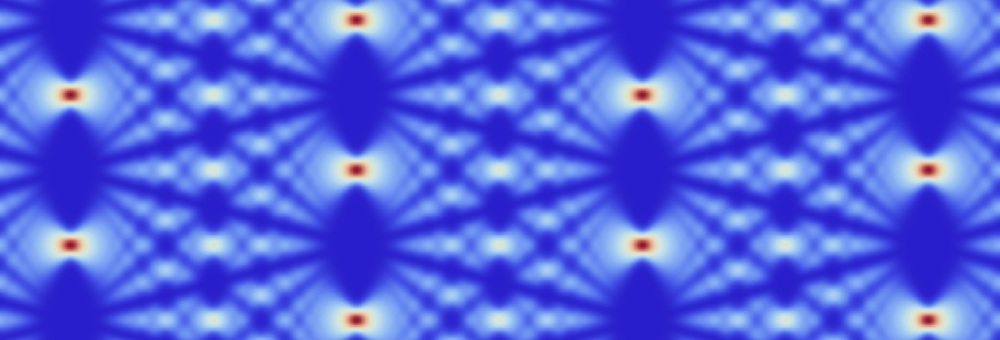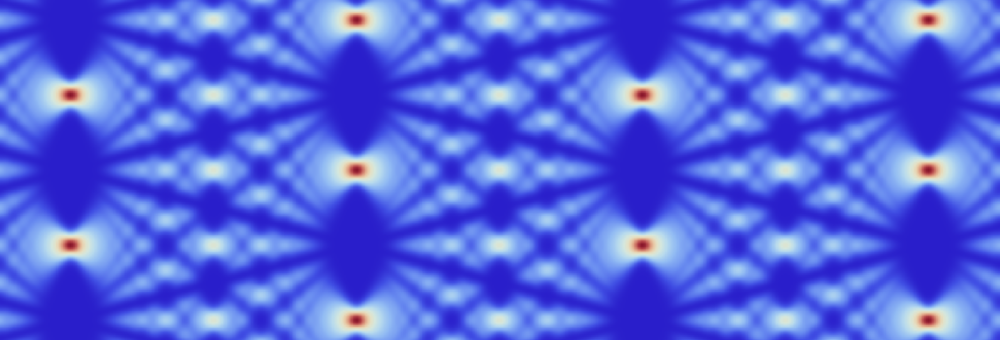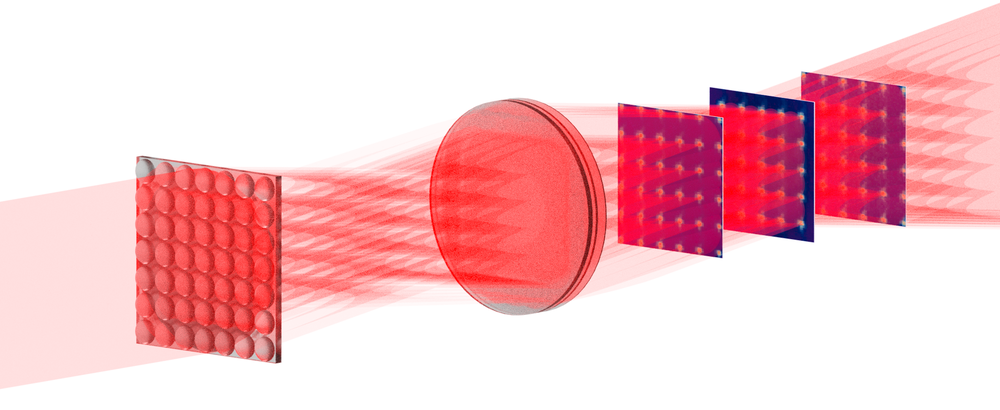Tweezers in Three Dimensions
Researchers have produced 3D lattices of trapped atoms for possible quantum computing tasks, but the standard technology doesn’t allow much control over atom spacing. Now a team has created a new type of 3D lattice by combining optical tweezers—points of focused light that trap atoms—with an optical phenomenon known as the Talbot effect [1]. The team’s 3D tweezer lattice has sites for 10,000 atoms, but with some straightforward modifications, the system could reach 100,000 atoms. Such a large atom arrangement could eventually serve as a platform for a quantum computer with error correction.
3D optical lattices have been around for decades. The standard method for creating them involves crossing six laser beams to generate a 3D interference pattern that traps atoms in either the high- or low-intensity spots (see Synopsis: Pinpointing Qubits in a 3D Lattice). These cold-atom systems have been used as precision clocks and as models of condensed-matter systems. However, the spacing between atoms is fixed by the wavelength of the light, which can limit the control researchers have over the atomic behavior.
Optical tweezers offer an alternative method for trapping and controlling atoms. To form a tweezer array, researchers pass a single laser beam through a microlens array (or similar device) that focuses the beam into a 2D pattern of multiple bright spots. Atoms are automatically drawn to the centers of these spots, forming an array in a single plane (see Viewpoint: Alkaline Atoms Held with Optical Tweezers). “We take these tweezer arrays to the third dimension,” says Malte Schlosser from the Technical University of Darmstadt, Germany.
To obtain a 3D lattice, Schlosser and his colleagues took advantage of the Talbot effect, which is an interference phenomenon that occurs when light strikes a periodic structure, such as a diffraction grating or a microlens array. The light exiting the structure produces a 2D interference pattern of bright spots at some fixed distance beyond the structure but also generates additional planes of spots parallel to the first one. The Talbot effect had long been considered a nuisance for tweezer array research, as it creates “extra” bright spots that trap stray atoms, which interferes with measurements. The researchers turned this “bug into a feature” by deliberately tuning their optical system to trap atoms in the extra bright spots, Schlosser explains.
The researchers shined an 800-milliwatt laser onto a microlens array, which produced a 2D square array of 777 atom traps at the focal plane of the lens. But thanks to the Talbot effect, this 2D array was reproduced in 17 parallel planes, giving a total of 10,000 atom traps. “These Talbot planes come for free, so we don’t have to put in additional laser power or additional laser beams,” Schlosser says.
As a demonstration of their system, Schlosser and his colleagues showed that they could load around 50% of the traps with rubidium atoms and induce an optical transition in all the atoms in a sublattice. In the future, the team plans to use a focused laser beam to selectively excite a single atom. Such optical control could allow researchers to “read” the atom’s state or to place it in a so-called Rydberg state that would let it interact with its neighbors. Control of atom–atom interactions has been previously demonstrated in 2D tweezer arrays. Schlosser foresees having atom–atom interactions in the 3D lattice, but currently the spacing between the planes is too large (around 100 µm); a distance of 10 µm or less would be required.
Besides squeezing down the spacing of the lattice, the team plans to explore other trap geometries, such as hexagonal patterns that could mimic materials like graphene. The researchers are also working to boost the laser power. More light will increase the number of traps in the lattice. They estimate that doubling the power would provide 30,000 traps and that quadrupling it should produce close to 100,000.
Schlosser and his colleagues “are tackling one of the most important challenges any quantum computing technology will face, which is scaling,” says Ben Bloom, founder and chief technology officer of Atom Computing, a quantum technology company in California. He says that the new design can create a large number of atom quantum bits at essentially no cost, but there will be challenges ahead in trying to control the atoms within the lattice. Still, controlling so many atoms will have practical benefits. “Pushing to large numbers of individually controlled atoms in 3D will allow for the exploration of new quantum error-correction codes,” Bloom says.
–Michael Schirber
Michael Schirber is a Corresponding Editor for Physics Magazine based in Lyon, France.
References
- M. Schlosser et al., “Scalable multilayer architecture of assembled single-atom qubit arrays in a three-dimensional Talbot tweezer lattice,” Phys. Rev. Lett. 130, 180601 (2023).







